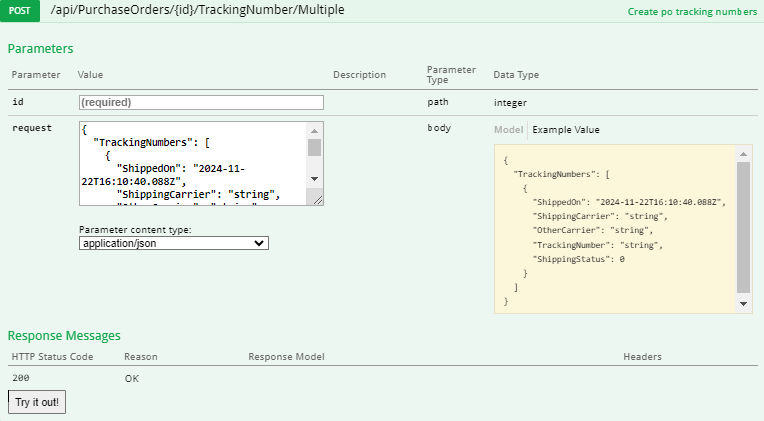Overview
This endpoint can be used to update the shipping information and tracking numbers on a single existing Purchase Order. Note that it will only work if the Client Setting Enable Multiple Tracking Numbers On PO is enabled. When disabled, use the Update PO Shipping Information (Single Tracking) endpoint instead.
To consume the endpoint, you must:
- Be an authenticated user.
For information on how you can authenticate, see Authentication.
After you authenticate and receive a valid token, you must pass it to service calls.
Endpoint
An example of this endpoint for XX server is:
- https://XX.api.sellercloud.com/rest/api/PurchaseOrders/{id}/TrackingNumber/Multiple
For your server, the endpoint will be:
- https://{your_server_id}.api.sellercloud.com/rest/api/PurchaseOrders/{id}/TrackingNumber/Multiple
Request
- Method Type: HttpPost
- Authorization: Use Bearer Token + token received from token authentication
- Header info: Content-Type: application/json
Request Body
| Parameter | Parameter Type | Data Type | Description | Required |
| id | path | Integer | ID of the targeted Purchase Order. | yes |
| TrackingNumbers | body | array | List of tracking numbers and shipping information to update. | yes |
| ShippedOn | body | DateTime | Date and time when the PO was shipped. You can only update this value if the PO Shipping status is not “None”. | yes |
| ShippingCarrier | body | String | Shipping Carrier Name. Possible values:
UPS |
yes |
| OtherCarrier | body | String | This should be populated if you have provided “Other” in the “ShippingCarrier” parameter.
Set to null or omit in the request if update of this field is not needed. |
no |
| TrackingNumber | body | String | Tracking Number. | yes |
| ShippingStatus | body | enum | The PO Shipping Status:
0 = None 1 = PartiallyShipped 2 = FullyShipped |
yes |
The request body should be formatted as follows:
{
"TrackingNumbers": [
{
"ShippedOn": "2024-11-22T16:10:40.088Z",
"ShippingCarrier": "string",
"OtherCarrier": "string",
"TrackingNumber": "string",
"ShippingStatus": 0
}
]
}
Response
- If the user is authenticated and the request is successful, the response is Status Code 200 => OK
- If the user is not authenticated, the response is Status Code 401 => Invalid Token
- In case of an error, the response is Status Code 500 => Internal Server Error
- In case of an incorrect request, the response is Status Code 400 => Bad Request
